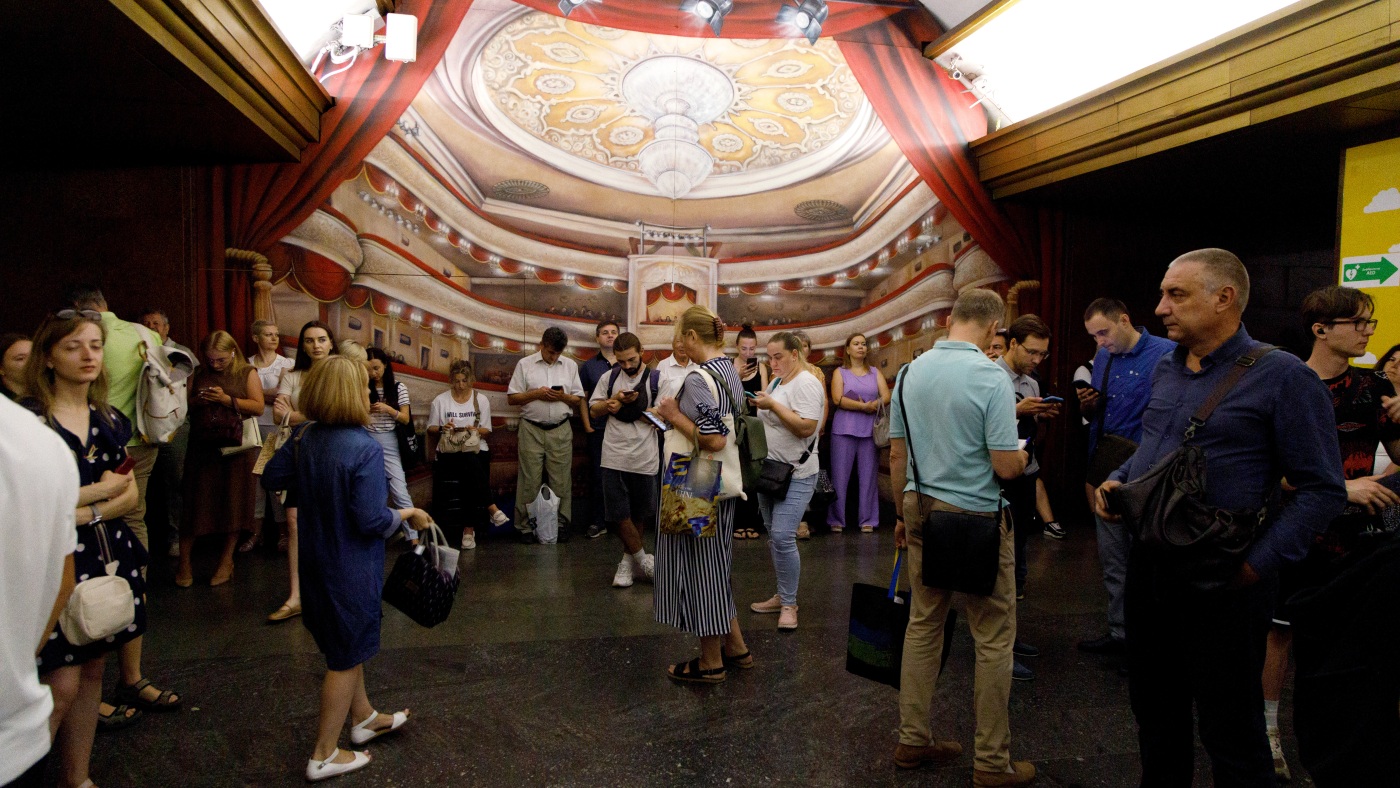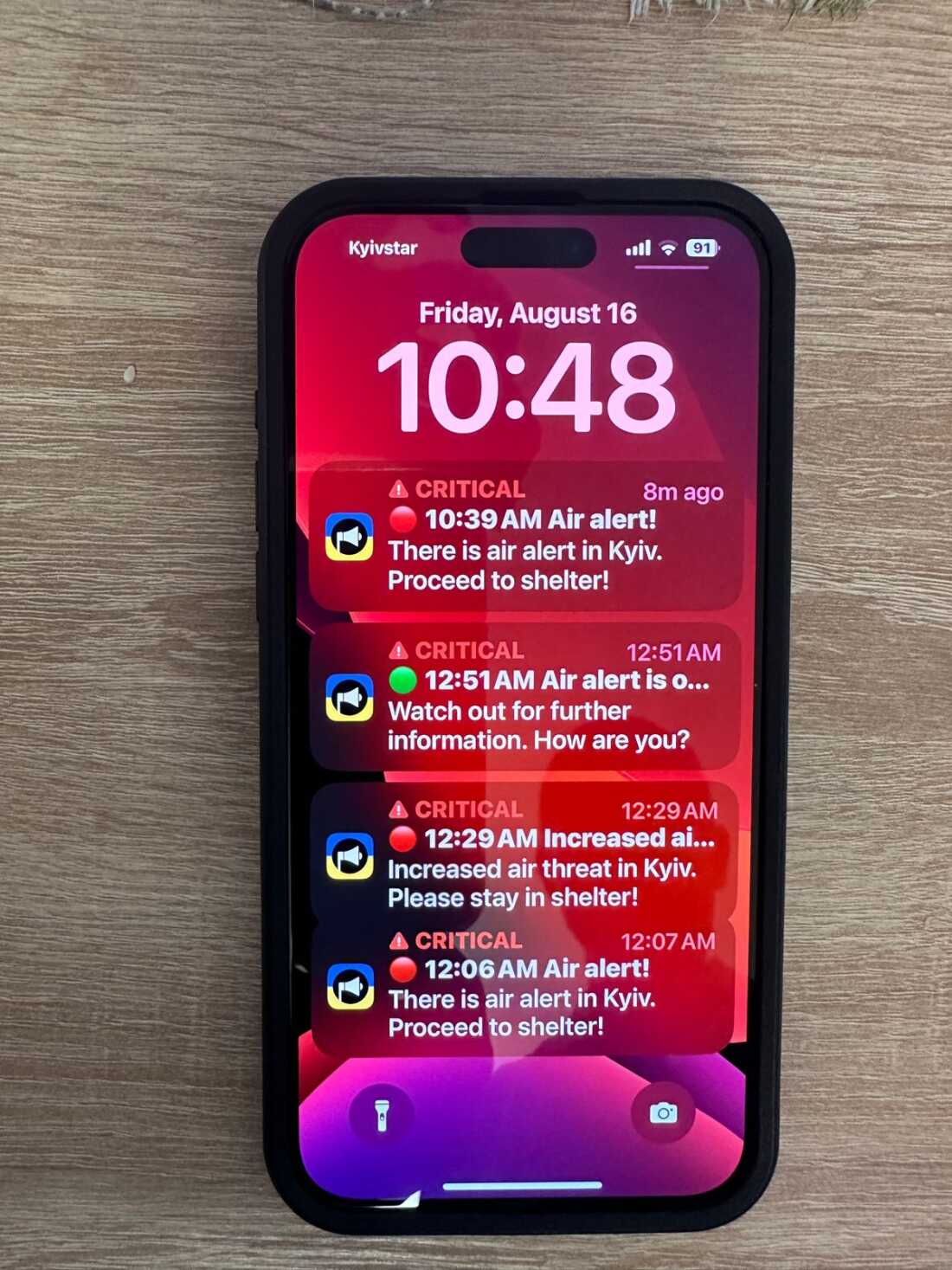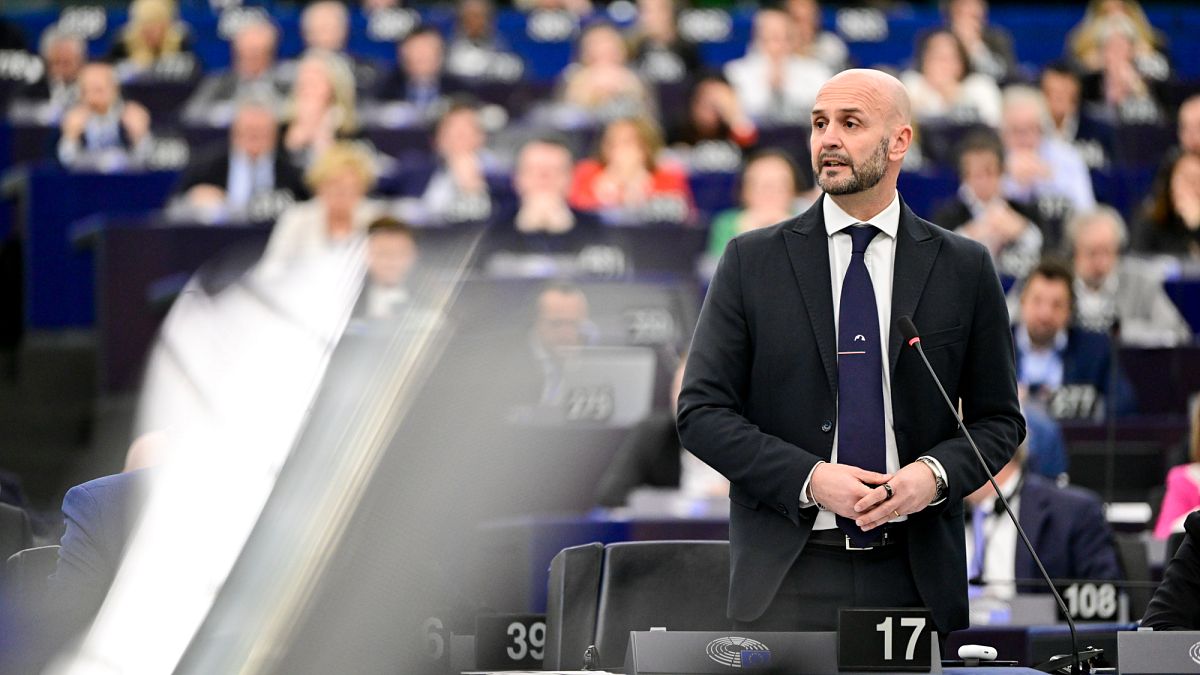Lifestyle
In Ukraine, turning air raid sirens into a piece of music

People wait out an air raid alarm at the Teatralna metro station during the massive Russian drone and missile attack in Kyiv, Ukraine, on Aug. 26.
Ukrinform/NurPhoto via Getty Images
hide caption
toggle caption
Ukrinform/NurPhoto via Getty Images
KYIV, Ukraine — Air raid sirens warning of Russian attacks are a constant in Ukraine. Thousands of the alarms have presaged Russian air strikes over the past two years. Some Ukrainians still take cover whenever they can. Others largely ignore them.
One of those sirens began to wail recently as a 28-year-old singer, Diana Oganesyan, was walking late at night in the capital Kyiv.
“I was on my way home from my friend’s birthday. The air siren just caught me in the middle of the street when there were no shelters nearby,” Oganesyan said. “So I was kind of stuck there.”
As a singer, she did what came naturally. She began to harmonize with the siren and recorded herself on her phone. When she posted it on social media, it went viral.
First of all, it’s beautiful. But actually this is what life in my country looks like during the last 2 and a half years. You just try to harmonize your life with constant air alerts and explosions that follow after. Unfortunately, it isn’t as beautiful as this girl and her song pic.twitter.com/KqLps5erVl
— diana khater (@KhaterDiana) August 21, 2024
“I didn’t expect it to get so much attention,” she said. “Of course, I’m not happy that [air strikes are] happening, but I’m glad that my voice and the power of social media are bringing attention to the war in Ukraine.”
She says her small act reflects the resilience of Ukrainians.
“No matter what’s happening, life has never stopped,” she explained. “We’re making art. We open businesses. Guys are opening restaurants now, making festivals, drawing flowers around the holes from the bullets. This is what we do.”
When Russia launches major airstrikes, as it has recently, some residents in Kyiv and other large cities with subway systems will go underground and wait out the assault. Occasionally, they spontaneously break into song, as they did here in Kyiv, expressing their love for the city.
This morning, russia launched more than two hundreds missiles and drones at Ukraine. In Kyiv, the air alert lasted for over 7 hours.
But in the Kyiv subway, the sounds of sirens and explosions were lost among voices singing “How can I not love you, Kyiv of mine?”
No matter how… pic.twitter.com/jjO9GwhTZu
— UNITED24 (@U24_gov_ua) August 26, 2024
In addition to the actual siren, Ukraine’s government created the Air Alert app that offers its own warning on cellphones.
“Attention! Increased air threat in your area! Please proceed to the nearest shelter,” it says.

A Ukrainian government app provides regular updates on Russian air raids.
Hanna Palamarenko/NPR
hide caption
toggle caption
Hanna Palamarenko/NPR
So how are Ukrainians coping?
“Previously, we always tried to find a bomb shelter,” said Olexander Velhus, a 27-year-old technology worker.
Like most Ukrainians, he said he took the sirens very seriously when the Russian airstrikes began nationwide with the full-scale invasion in February 2022. That often meant getting out of bed on a freezing night and walking with his girlfriend 100 yards to an office building with a secure basement.
How do they respond now?
“We just accept our fate,” he said with a chuckle.

A billboard in Kyiv directs people to the nearest air raid shelter.
Greg Myre/NPR
hide caption
toggle caption
Greg Myre/NPR
Russian airstrikes can last for hours, and come most frequently during the night. The initial siren often means Ukraine has detected Russian warplanes, likely armed with long-range missiles, taking off hundreds of miles away, deep inside Russia.
After 15 minutes or so, the phone app usually provides an update. It can be an “all clear” for your area — or an ominous notice saying your region is a target.
Then, another half-hour can pass before you hear window-shaking booms as Ukrainian air defenses launch missiles at the incoming Russian weapons.

“Basically, we wake up when we hear explosions,” said Velhus. “Then we decide whether we want to go to the shelter or not.”
He’s in Kyiv, where air defenses are extremely good. The shootdown rate is over 90%. But other parts of Ukraine are much more vulnerable, particularly in the east and the south, near the front lines.
The singer, Diana Oganesyan, now divides her time between Kyiv and London. She still performs in Ukraine’s capital under her stage name Melancholydi.
“We’re still making music, we’re still making art,” she said. “It doesn’t mean it’s easy. The conditions are worse, but they still do it because we are Ukrainians. That’s what we do.”

Lifestyle
She’s Young, Trump-Friendly, and Has a White House Press Pass

The waitress was pouring tap water. But Natalie Winters was quick to ask for bottled.
“No fluoride for our dear dinner guest!” she said, gesturing to me. “Only filtered water and pesticide-free limes.”
We were sitting in the back corner of Butterworth’s, a Capitol Hill bistro that has become a destination for friends and supporters of President Trump. Stephen K. Bannon, Ms. Winters’s current boss, has hosted private events there. Her former boss, Raheem Kassam, the editor in chief of The National Pulse, is an investor. The menu that night featured lamb tartare, oysters brûlée and pork cheeks.
Ms. Winters and I had met for dinner, or so I had thought. “Honestly,” she said, “I’m probably not going to eat because that’s my brand. I don’t eat at restaurants because I don’t like the seed oils that they use.”
At 24, Ms. Winters has been a White House correspondent since Jan. 28. She reports for Mr. Bannon’s “War Room” podcast, whose audience includes large swaths of the Republican base, high-level officials and the president himself.
She belongs to a group of journalists from conservative outlets who have taken on a new national prominence in recent months as they jostle for positions in the cramped James S. Brady Press Briefing Room. The White House press secretary Karoline Leavitt has described long-established news media organizations as increasingly irrelevant while accusing them of spreading “lies.”
The White House Correspondents’ Association, which includes journalists from dozens of outlets, has criticized the new administration’s handling of the press, saying it discourages independent reporting and gives priority to those who favor President Trump’s agenda. But the elevation of nontraditional outlets has been a good thing for Ms. Winters and some other journalists in the West Wing, including those representing Breitbart News and Lindell TV, the platform founded by the conspiratorial MyPillow salesman Mike Lindell.
When Ms. Winters is not seated beside Mr. Bannon in the basement studio of his townhouse near the Capitol, she is often reporting to the loyal “War Room” audience from outside the White House, delivering off-the-cuff monologues that pillory Democrats and, sometimes, her fellow reporters.
“It’s very gonzo, which I like,” she said. “I think of it as an I.Q. test every day.”
Ms. Winters describes herself as a “populist nationalist,” like Mr. Bannon. She says she “detests” more Republicans than she admires. She frequently attacks party leaders like Speaker Mike Johnson and usually supports Mr. Trump.
“Even though I agree with most of what Trump does,” Ms. Winters said, “it’s because I ideologically agree with him. Not because I am a cultist.”
She counts Mr. Bannon not only as her co-host and boss, but also as her mentor. When he went to federal prison last year for defying a subpoena from a congressional committee investigating the Jan. 6 riot, he entrusted her to host “War Room” in his absence.
Since Mr. Trump’s reascension, her profile has skyrocketed to the point where she says she is recognized in restaurants and airports. She says her parents have been surprised by her often combative onscreen persona.
“It’s such a different version of myself than I am in my day-to-day life,” she said, adding, “I don’t even recognize myself.”
Ms. Winters grew up in Santa Monica, Calif., the daughter of a physician father and a stay-at-home mother. She attended Harvard-Westlake, an elite prep school in Los Angeles, and was relatively apolitical until the 2016 campaign was underway.
Various school activities struck her as liberal-coded and performative. First it was a bake sale intended to raise awareness of the gender pay gap. “Just straight-up bogus,” Ms. Winters said. Then came the student walkout in protest of gun violence after the mass shooting at Marjory Stoneman Douglas High School in Parkland, Fla. “A school-sanctioned walkout,” she said. “What are you doing?”
Her only published piece in the high school paper was a letter to the editor in which she made the case for the confirmation of Brett Kavanaugh to the Supreme Court. It was not well received on the mostly liberal campus. Because of her conservative views in general and her support of Mr. Trump in particular, she was ostracized by her peers, she said.
“Maybe the trope that everything goes back to high school trauma is true,” she added.
During her senior year, after she learned she had gotten into the University of Chicago, she more or less stopped going to class. She skipped her high school graduation day because she was flying to Washington to start working as an intern for Mr. Kassam, who was then a “War Room” co-host. She also missed out on prom. “It was the best thing I ever did,” she said.
During her first year of college, Ms. Winters became a “War Room” staff writer. She frequently commuted to Washington instead of attending class. “My best friend from college is, like, Steve,” she said, referring to Mr. Bannon. As Covid spread across the globe, she made her first on-camera appearance.
“The pandemic’s really where she got her sea legs,” Mr. Bannon said in a phone interview. He used some baseball-scout lingo to describe Ms. Winters, calling her “a five-tool player.”
She has raised her visibility with her appearances on “Piers Morgan Uncensored,” a YouTube talk show hosted by the former CNN personality. “She is always a lively and provocative contributor, even if I don’t agree with many of her views,” Mr. Morgan said by text. But Ms. Winters insists she’d be happy spending her days sifting through federal databases.
“She’s essentially a nerd at heart,” Mr. Bannon said.
One of the biggest feuds on the right has been between Ms. Winters’s boss and Elon Musk, who, with the president’s blessing, has embedded himself within the federal government. At the height of the rift, Mr. Bannon called Mr. Musk a “truly evil person.” In response, Mr. Musk wrote on X: “Bannon is a great talker but not a great doer.”
The spat has put Ms. Winters in a unique position. Mr. Musk is one of her 630,000 followers on X, and he frequently reposts her. She has lauded him and his leadership of the Department of Government Efficiency.
“I think I’m the only person who could bring them together and get peace,” she said, laughing.
Ms. Winters may be a White House correspondent, but her job is not so much to cover Mr. Trump’s avalanche of executive actions as it is to report and comment on what she labels “opposition forces,” whether they be Democratic politicians, liberal organizations or major news outlets.
Hugo Lowell, a White House correspondent for The Guardian, said that Ms. Winters differs from other reporters on the beat because she is “vocal about her own political views and clearly infuses them into her coverage.”
“But she’s good on TV,” Mr. Lowell added, “and she has built up an audience with Trump’s base that translates to a degree of influence in a fragmented media ecosystem.”
Ms. Winters compared the White House briefing room to high school. “This is my first time in a professional setting where my MAGA royalty clout means nothing,” she said.
Her outsider status was confirmed when the National Press Club rejected her bid to become a member. Asked about the denial of Ms. Winters’s application, a spokesperson for the organization, which was founded in 1908 and has roughly 2,500 members, said: “Decisions are made in alignment with the standards of journalism we uphold. We do not publicly comment on individual applications out of respect for all involved.”
Many White House reporters affiliated with large news organizations do not talk to her, Ms. Winters said, and several of them contacted for this article declined to comment. But, ultimately, someone who has blasted much of the news media as “ground zero of left-wing opposition to Trump” was always going to be in for a chilly reception.
At Butterworth’s, true to her word, Ms. Winters had only bottled water during our three-hour talk.
She said she has had two drinks in her life and has never done drugs. She also has a budding lifestyle brand. Items for sale include a tank top with “More insecure than the border” plastered across the front and a tote that reads “A little conspiratorial.”
Her cable news network of choice is MSNBC, which she watches partly to generate material. She said that in another world she might have been a poetry professor. “I always joke — in my day-to-day life, I really am a lib at heart,” she said.
She also loved “Barbie” and agreed with the monologue delivered by America Ferrera, in which her character says, “It is literally impossible to be a woman.” But, Ms. Winters caveats, “It’s also really hard to be a man.” She added that scores of women younger than she had asked her not only for career advice but also for tips on how to be like her.
Like a growing Gen-Z contingent, she is “anti-app,” meaning dating apps. One day, she would like to settle down with a man she can be “submissive” to, she said. She added that she had been wronged in past relationships, which only stoked her ambitions.
“I was like, ‘I’m going to get revenge,” she said. “You can watch me on TV being the next big deal.’”
Lifestyle
How to have the best Sunday in L.A., according to Amanda Gorman

Growing up in Westchester, Amanda Gorman’s Sundays were dedicated to one thing: church.
“I went to a historically Black church and I feel like it’s always an occasion to go to church as an African American,” says 27-year-old Gorman, who became the youngest inaugural poet in U.S. history in 2021. “You’re dressing up in your Sunday best and you’re going to be there for several hours.”

In Sunday Funday, L.A. people give us a play-by-play of their ideal Sunday around town. Find ideas and inspiration on where to go, what to eat and how to enjoy life on the weekends.
These days, her Sundays are not entirely devoted to church, but the poet, activist and author says that those early years taught her the importance of intentionally carving out time to spend with loved ones and be in community.
“It can be getting together with some gal pals that you haven’t convened with in a while,” says Gorman, who became the youth poet laureate of Los Angeles at age 16 in 2014 and the first national youth poet laureate three years later. “It can be spending time with your pets. It can be going to the book club that you love, but finding something where you can ground yourself in what it is to be a human being. I think I still try to translate that into my Sundays.”
Gorman is set to make her second appearance at the Los Angeles Times Book Festival on April 26, where she’ll be talking about her third book, “Girls on the Rise,” released this year. The Harvard graduate began writing the children’s book in 2018 after she watched Christine Blasey Ford — who accused Justice Brett M. Kavanaugh of sexually assaulting her when they were teenagers — testify to the Senate Judiciary Committee.
“I just remember being so struck by her courage, bravery and truth,” says Gorman. “It made me think about the next generation of young women, girls and nonbinary children, who also would be speaking their truth in a patriarchal society. So I wanted to write a book that created a safe space for young girls and their allies to feel a sense of kinship.”
On her ideal Sunday in L.A., Gorman would hang out with her dog, Kenny (named after Kendrick Lamar), visit her favorite bookstores, enjoy afternoon tea like a “Bridgerton” character and hit up a rooftop.
This interview has been lightly edited and condensed for length and clarity.

10 a.m.: Embrace brunch vibes at home
If I can sleep in until 10 a.m., that’s like a miracle, magical day for me. I love just taking the extra time on a Sunday. Breakfast is my favorite and maybe my main meal of the day if I’m being honest. So I will carve out Sunday as my day to really splurge on my breakfast. I’ll maybe make some french toast. I have been dallying and making a gluten-free french toast with some nice seeds, vanilla, cinnamon and berries. Then I’ll make some veggie patties and have some other fruit. I’ll also make some hot chocolate and then I’ll put on “The Great British Bake Off” show while I’m cooking, so I can really luxuriate in the Sunday chill vibes. I pretty much start the day with as much brunch energy as I can.
12:30 p.m.: Get some sunshine
I’d love to get some sunshine, so I’d go to the beach. I love taking a stroll with my friends along the Santa Monica Pier, kind of on the northern side because it’s a bit less crowded.

3 p.m.: Live out my ‘Bridgerton’ fantasy
By this time, I’d be hungry and ready for lunch. If I was down by the beach, there’s a restaurant I like called Ivy at the Shore, kind of close to the Third Street Promenade. You can eat and watch the sunset. They have a good salad. I’ve also gotten really good enchiladas there, and fish and chips.
Or I’d go to the Peninsula. For my birthday, I just did an afternoon high tea at the Peninsula. It was so nice and so worth it. I feel like if someone wants to splurge on a Sunday, go. They have a harpist, tea, sandwiches and scones, so I’d probably spend the rest of my afternoon there on my dream, ideal day. You can sit in their parlor lounge, which has these nice, colorful couch sofas or these elegant corner chairs. They have music playing and very snazzily dressed butlers. One of my friends wore a fascinator. I wore lace gloves. I said, “Come in your ‘Bridgerton’ aura.” It really feels like “Bridgerton” because on the show, they have the instrumentalists playing modern songs and they were playing like “Diamonds” by Rihanna on the harp, so I love that mix of the contemporary with the classic and bougie.
5:30 p.m.: Get lost in a bookstore
Next, I’d go to the Last Bookstore in DTLA or Chevalier’s Books in Larchmont. The Last Bookstore has an enthralling, picturesque maze of used and new books, and Chevalier’s is a cozy, intimate bookshop with stores and cafes nearby.

7 p.m.: Catch a second wind at a rooftop restaurant
I’d probably go home, but if I got a second wind of energy, there are some really nice restaurants that I like in West Hollywood. There’s Catch L.A. and Perch. Both are really cute, glitzy rooftop places to go after the sun has set. Catch L.A. has a “Hit Me” chocolate cake, where they pour melted chocolate over it and crack it open in front of you, so that’s really nice. Tons of people love to take videos of that and post it because it’s a real moment.

10 p.m.: ‘Great British Bake Off’ and tea
I’m probably home, watching some more “British Bake Off,” “The Office” or something cozy, making myself some chamomile tea and reading. That’s also the thing I love to do on Sundays because I feel like it’s so hard to find time nowadays, in the modern age, to step away from the screen and engage stories and text. I was reading this book that’s really funny to me called “How to Kill Your Family.” [Laughs] I was like, I feel like my family is going to see me reading this at like Thanksgiving and think I’ve gone unhinged, but it’s this dark thriller comedy that was published in the U.K. I just finished it and I thought it was hilarious. It’s not a step-by-step guide, by the way. It’s more a narrative of a character’s journey [laughs].

11 p.m.: Wind down
I discourage the elaborate nighttime routines because I think they’re hard to maintain and sustain. I try to make it as straightforward as possible, which gives a good routine for me as well as my dog. So my nighttime routine would be giving my dog a walk and making sure he has time to pee and do all the nature stuff. Reading, having chamomile tea and maybe doing some slow restorative yoga for 10 minutes or a meditation. I get the humidifier all set with essential oils, turn the lights down and try to have the last hour with no blue light, sugar, food, and keep it really quiet and soft. I also like to listen to lullaby music, which makes me sound like a fetus, but it helps me get over my insomniac tendencies. I like this artist, Priscilla Ahn, who has really soothing albums that are good for all ages. Then honestly, I’ll listen to the Disney princess playlists with songs like “So This is Love” [by Ilene Woods and Mike Douglas], all that soft, cozy stuff. I try to be in bed by 11:30 p.m.
Lifestyle
What to Expect From Bravo’s Nepo Baby Reality Show, ‘Next Gen NYC’

Bravo is making a big bet on the Gen Z offspring of some of the most famous stars from its “Real Housewives” franchise. The network released a trailer this week for “Next Gen NYC,” a show that will follow the lives of four young reality scions and their influencer peers as they navigate work, life and love in Manhattan.
For the reality connoisseurs among us, try to imagine “Rich Kids of Beverly Hills” meets “NYC Prep.”
For everyone else, here’s a primer.
Who’s on the show?
The cast features the offspring of four “Real Housewives”: Ariana Biermann and Riley Burruss, the daughters of the former “Real Housewives of Atlanta” stars Kim Zolciak-Biermann and Kandi Burruss; Brooks Marks, the son of the “Real Housewives of Salt Lake City” favorite Meredith Marks; and Gia Giudice, the daughter of the “Real Housewives of New Jersey” legend Teresa Giudice.
The rest of the cast is made up of a handful of influencers and so-called nepo babies, including Ava Dash, a daughter of the record executive Damon Dash and the fashion designer Rachel Roy; Emira D’Spain, a model and influencer who will be Bravo’s first full-time trans cast member; Georgia McCann, a creative strategist Bravo describes as “New York’s ultimate Gen Z It girl”; Charlie Zakkour, a crypto trader and club kid; Hudson McLeroy, Ms. Biermann’s on-again, off-again boyfriend and the heir to the fast-food chain Zaxby’s; and Shai Fruchter, an assistant at the Wall Group.
What kind of drama can be expected?
“Next Gen NYC” looks relatively restrained compared with the high-stakes drama on some of the editions of “Real Housewives.” (Legal battles! Shocking divorces! Physical altercations!) But the show has teased Ms. Dash and Ms. Biermann feuding over fashion, and Ms. Biermann cursing out Mr. Marks as Ms. Giudice deadpans, “This is so stupid.”
There’s also the drama inherent to being a young New York transplant, such as Ms. Biermann declaring she’s “absolutely petrified” riding the subway, or Ms. Burruss accidentally tossing her phone into the Hudson River.
Will there be any ‘Real Housewives’ cameos?
According to Bravo, there will be plenty — and that’s probably what they’re counting on to boost audience numbers. All of the Housewives whose children appear on the show are slated to make appearances. In the trailer, which was released this week, viewers get a glimpse into Mr. Marks’s “tumultuous work relationship” with his mother and at Ms. Zolciak-Biermann balking at a $14,000 night out. Seth Marks, the husband of Ms. Marks and father of Brooks, also factors heavily into the trailer, asking his son awkward questions about his sex life and saying he’s attached to his mother “like a little baby kangaroo.”
Will it be worth watching?
Honestly, this series feels like a deep cut. People who are not Bravo obsessives should approach with caution. But for those who can rattle off every Housewife by memory, the show premieres June 3 at 9 p.m. Eastern time on Bravo and will be available on Peacock the following day.
-

 News1 week ago
News1 week agoSupreme Court Rules Against Makers of Flavored Vapes Popular With Teens
-

 News1 week ago
News1 week agoNYC Mayor Eric Adams' corruption case is dismissed
-

 Technology1 week ago
Technology1 week agoHere’s how you can preorder the Nintendo Switch 2 (or try to)
-

 News1 week ago
News1 week agoTrump to Pick Ohio Solicitor General, T. Elliot Gaiser, for Justice Dept. Legal Post
-

 Politics1 week ago
Politics1 week agoFBI flooded with record number of new agent applications in Kash Patel's first month leading bureau
-

 World1 week ago
World1 week ago‘A historic moment’: Donald Trump unveils sweeping ‘reciprocal’ tariffs
-

 Sports1 week ago
Sports1 week agoDeion Sanders defied doubters and returns to Colorado with a $10M per year deal. What’s next?
-

 World1 week ago
World1 week agoCommission denies singling out NGOs in green funding row














